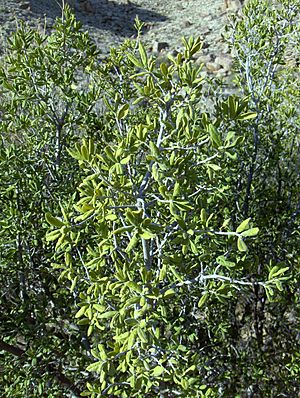Texas persimmon facts for kids
Quick facts for kids Texas persimmon |
|
|---|---|
 |
|
| Scientific classification | |
| Genus: |
Diospyros
|
| Species: |
texana
|
 |
|
| Natural range | |
The Texas Persimmon (scientific name: Diospyros texana) is a type of persimmon tree. It grows naturally in central, south, and west Texas and southwest Oklahoma in the United States. You can also find it in eastern Chihuahua, Coahuila, Nuevo León, and Tamaulipas in northeastern Mexico.
People often call it the Texas persimmon or Mexican persimmon. Sometimes it's also called "black persimmon". In Spanish, it's known as chapote, chapote manzano, or chapote prieto. These names come from the Nahuatl word tzapotl, which also refers to other fruit trees.
Contents
About the Texas Persimmon Tree
The Texas Persimmon is a small tree or a large shrub. It often has many trunks. These trees usually live for 30 to 50 years. They typically grow to about 3 meters (10 feet) tall. But in good spots, they can reach up to 12 meters (39 feet) high!
The bark is smooth and light reddish-gray. On older trees, the bark peels off. This shows pretty shades of pink, white, and gray underneath.
Leaves of the Tree
The leaves are dark green and tough. They are shaped like an oval, wider at the top. Each leaf is about 2 to 5 centimeters (0.8 to 2 inches) long. They are also about 1 to 3 centimeters (0.4 to 1.2 inches) wide. The top of the leaves is shiny. The bottom has tiny hairs. The leaves attach to small stems called petioles. These are about 0.1 to 0.5 centimeters long.
In the northern parts of its home range, the tree loses its leaves in winter (it's deciduous). But further south, it stays green all year (it's evergreen).
Flowers and Reproduction
Texas Persimmon trees have separate male and female plants. This means you need both a male and a female tree for fruit to grow. They start making flowers in March or April. The flowers are white and shaped like a small pot. They are about 0.8 to 1.6 centimeters (0.3 to 0.6 inches) wide.
Each flower has five outer leaves called sepals. It also has five petals. Male flowers have 16 stamens (which make pollen). Female flowers have four styles (which receive pollen). The flowers grow alone or in small groups of two or three.
Fruit of the Texas Persimmon
The fruit of the Texas Persimmon is a black, round berry. It is about 1.5 to 2.5 centimeters (0.6 to 1 inch) across. The berries become ripe in August. Inside, each berry has three to eight light red, triangle-shaped seeds. These seeds are about 0.8 centimeters (0.3 inches) long.
Where Texas Persimmon Lives
You can find Texas Persimmon trees from sea level up to 1,800 meters (5,900 feet) high. They live in different areas like the Edwards Plateau and the Chihuahuan Desert. They also grow in parts of the Western Gulf coastal grasslands, the Tamaulipan mezquital, and the Tamaulipan matorral.
These trees like to grow near rivers and streams. They also like the edges of prairies and rocky hillsides. They prefer soils that drain water well and are alkaline (not acidic).
How People Use Texas Persimmon
The wood of the Texas Persimmon is very useful. The outer part of the wood, called sapwood, is clear yellow. The inner part, called heartwood, is black. This black heartwood is like ebony wood, which comes from a related tree called D. ebenum. You only find this black heartwood in very old, large trees.
The heartwood is hard and strong. It can be polished to a very smooth, shiny finish. People use it to make things like engraving blocks, art, and tools.
The soft, fleshy berries are good to eat when they are ripe. They taste sweet and are used in puddings and custards. Many birds and animals also love to eat them. But be careful, unripe berries taste very bitter!
Long ago, Native Americans used the berries to make a black dye. They used this dye for animal hides. People in Mexico still use it for this purpose today.
Because of its small size, peeling bark, interesting branches, and ability to handle dry weather, the Texas Persimmon is also a popular plant for gardens.
Texas Persimmon and Other Living Things
The Texas Persimmon is an important plant for some caterpillars. It is a host plant for the caterpillars of the grey hairstreak (Strymon melinus) butterfly. It also hosts the caterpillars of Henry's elfin (Callophrys henrici) butterfly.
See also
 In Spanish: Diospyros texana para niños
In Spanish: Diospyros texana para niños


